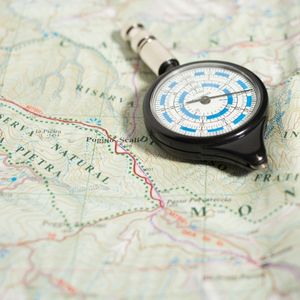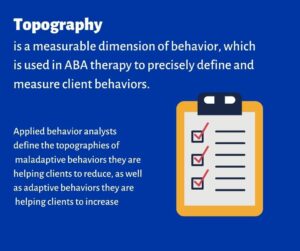
Topography: The Form of Behavior

Date Published: July 11, 2022
Author: Ysabel Zagala, RBT, (MA candidate)
In the field of applied behavioral analysis (ABA) we often talk about the form and shape of a behavior, also known as topography. Cooper et al. defines topography as, “… the physical form or shape of a behavior, the measurable and malleable dimension of behavior” (2020, p.82). It is important to understand the topography of a behavior so that when we are observing the behavior it can be accurately measured.
To help understand the topography of a behavior, a Board Certified Behavioral Analyst (BCBA) will write an operational definition of the behavior. An operational definition is when a behavior is described in terms of verbal, physical, spatial, and temporal dimensions (Cooper et al., 2020). For example, let’s say that we were measuring the number (tally) of times that someone greets someone else. The word “greet,” is in itself vague. A BCBA can operationally define the term “greet” as “someone waving their hand while the body is oriented towards the recipient of the greeting while saying a verbal greeting such as ‘hi,’ or ‘hello.'” With the operational definition of the behavior, we then will understand the topography of the behavior.
Another aspect of topography is understanding the magnitude of a behavior. Magnitude refers to the intensity of a behavior (Cooper et al., 2020). Continuing on with our greeting example: Say that when someone is greeting a stranger the intensity of the greeting is lower and smaller than if someone were greeting an old friend. The topography of the greeting of the stranger would look like a small wave along with a quiet vocalization of the word “hello,” whereas when greeting an old friend the topography looks like a hug lasting more than 3 seconds along with vocalization of “how are you, how have you been?”
Describing the shape, form, and magnitude of the behavior can also tell us how different environmental factors affect the topography and measurement of the behavior. When someone is greeting (i.e., saying “hello,” and having a short conversation about their day) a friend in a crowded place, the greeting may last 1 minute. However, if the greeting occurs at a coffee shop the duration (length) of the greeting could be for 5 minutes. The environmental factors affect the outcome and the topography of the behavior. In the field of ABA specific details about the behavior, outcome (consequences), and the environmental factors help us to understand how a behavior looks as well as the function of the behavior.
References:
Cooper, J. O., Heron, T. E., & Heward, W. L. (2020). Applied Behavior Analysis. Pearson Education, Inc.
About the Author:
Ysabel Zagala, RBT, (MA candidate) is a Registered Behavior Technician on the Faces Behavioral Services team. Faces Behavioral Services is a department of the Pacific Autism Center for Education that supports children with autism in reaching their full potential utilizing Applied Behavior Analysis (ABA).
Disclaimer: “Keeping Up the PACE” is a blog operated by Pacific Autism Center for Education with information provided by professional therapists. This content is not intended for the purpose of diagnosis of any condition. If you have a question for our team, please email us at email hidden; JavaScript is required.


